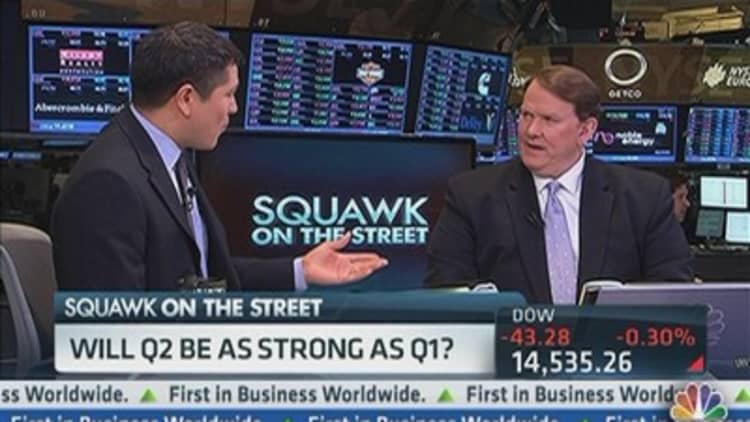The stock market's catapult to record highs could be the very thing that leads to the much-awaited pullback, with the threat being that equities could get too expensive for their own good.
Corporate stock purchases have been the principal driver of the market's surge off its March 2009 lows, as companies have helped levitate prices through nearly $1.2 trillion in buybacks since the beginning of the third quarter in 2009, according to Standard & Poor's data.
During that same time, individual investors have pulled a net of more than $250 billion out of mutual funds, according to records from the Investment Company Institute that indicate the retail crowd has mostly fled the stock market and put the bulk of its money in cash or bonds. Mutual funds are seen as a proxy for mom-and-pop investors who use funds and 401(k) plans to put money into the market.
Companies have been able to be so aggressive because the Federal Reserve has kept money cheap. The U.S. central bank has held its target funds rate near zero to maintain low borrowing costs, while it also has flooded financial markets with more than $3 trillion in liquidity through money creation.
(Read More: Fed May Be Able to Pull Back on Stimulus This Year: Lockhart)
While those policies likely will be kept in place through at least the end of 2013, the other side of the equation is changing.

Stock prices are no longer so cheap, and companies wishing to continue buybacks will have to do so at a premium.
"You would think that corporate treasury departments would start to look at stock prices and earnings prospects, and they'd be smart to wait," said Scott Armiger, chief investment officer at Christiana Trust, a Greenville, Del.-based company that manages $15 billion for clients. "They'll be able to do their buybacks at a much more attractive price in the not-too-distant future."
As part of a growing crowd that is anticipating an overdue pause from a surge past all-time highs for the and the Dow Jones Industrial Average, Armiger is advising clients to get more defensive.
That entails overweight allocations to defensive sectors such as consumer staples and health care.
History jibes well with Armiger's recommendations.
(Read More: Markets Sending Unusual Signals: El-Erian)
In previous years when the market has had strong first-quarter starts, it generally finishes higher for the year and is led by the same sectors that powered the early rally.
This year could well carry on that tradition as worried investors reluctantly come back to the market but still choose to play it safe.
"We believe that many of the retail investors who resisted the temptation to re-enter the equity markets earlier in this recovery are now doing so reluctantly," Sam Stovall, chief equity strategist at S&P/Capital IQ, said in a report for clients. "As a result, they are agreeing to buy stocks again, but only if they can play it safe by purchasing issues in the lower beta, defensive sectors.
"In other words, they are willing to go to the amusement park, but only if they can ride the merry-go-round, rather than the roller coaster."
Health care has led the 10 S&P 500 sectors this year, with a 15 percent gain, followed by consumer staples at 14 percent and utilities at 11.6 percent.
The S&P itself has been forecasting a pullback but recently amped up its full-year target to 1,670 from 1,550.
(Read More: Investors May Hate Bonds, but They Keep on Buying)
The bullish hope is that a pullback is likely to be short-lived and won't stop the market from rocketing forward and building on its new records.
"With widespread expectations for a pullback, and many looking to buy on the dip, any near-term pullback we get could be shallow and short-lived," Savita Subramanian, equity and quantitative strategist at Bank of America Merrill Lynch, told clients. "Fundamentals and valuations remain attractive, and investors continue to be skeptical of the strength and sustainability of this bull market. That is all very bullish for equities."
The market, though, has banked on low volatility due to Fed liquidity policies and relative geopolitical calm. While the former factor can be controlled, the latter cannot.
Capital Economics recently said in a report that "the recent low levels of volatility are only a brief respite due to transitory factors."
"Potential triggers for a rebound in volatility therefore include a renewed flare-up of the crisis in the euro-zone, the withdrawal of exceptional monetary stimulus and a variable pace of monetary and fiscal tightening in different countries," economists Julian Jessop and Andy Evans said. "Government bond yields also have to return to more normal levels at some point and this is likely to affect all markets to different degrees."
Should the conditions change, then, so could the willingness of companies to prop up the market.


